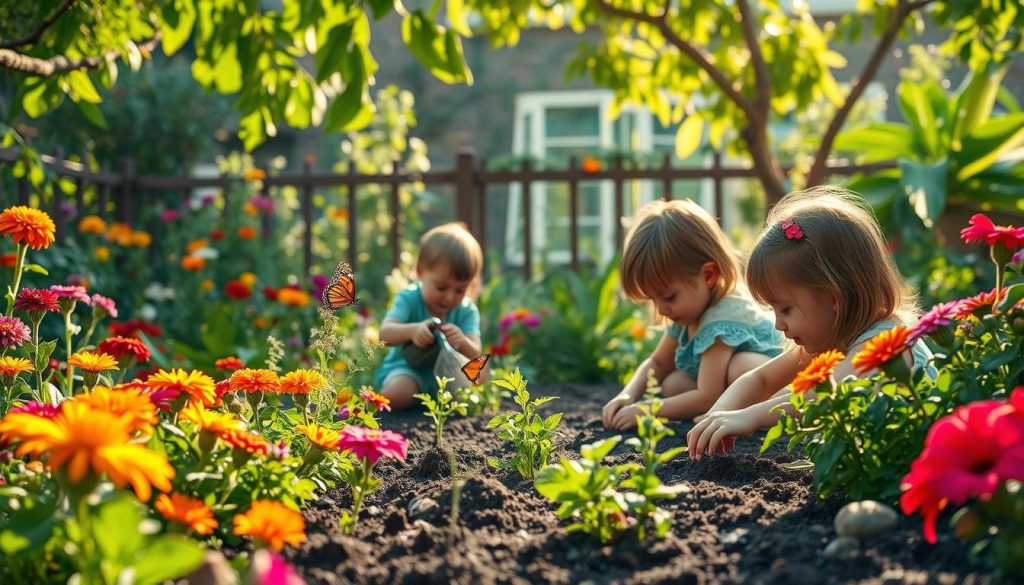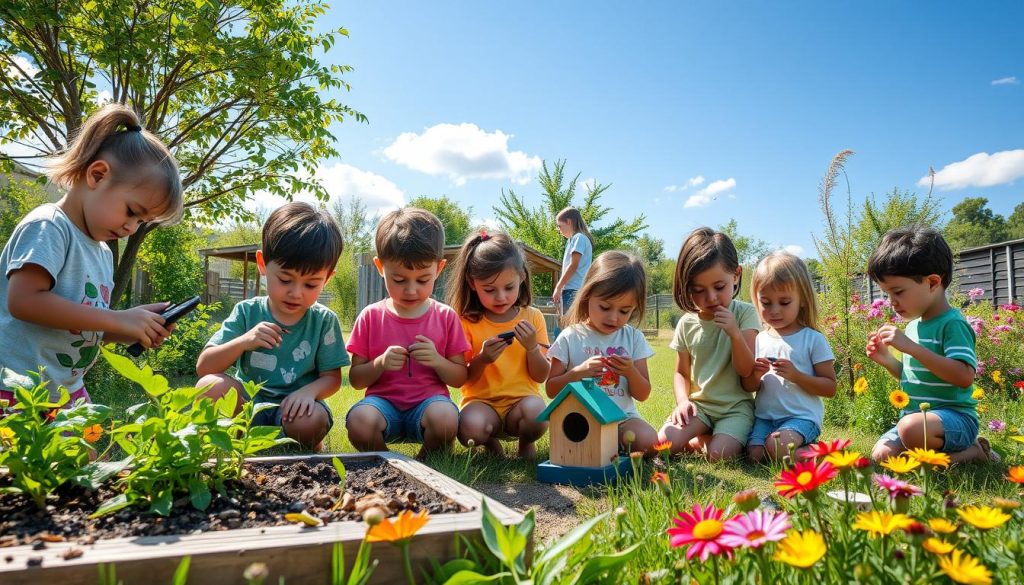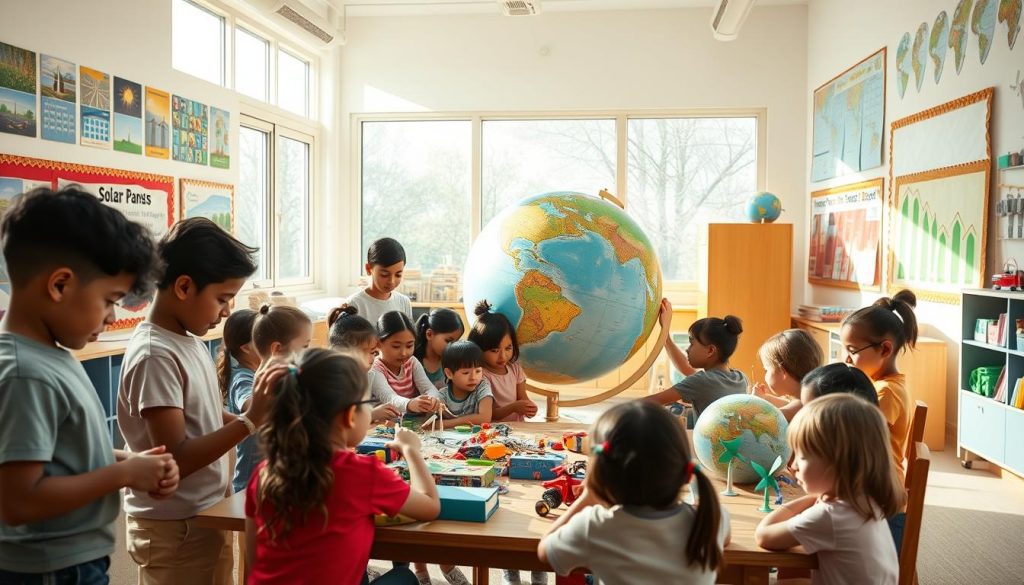I’m passionate about teaching kids about green living. I want to share fun ways to make learning about the environment exciting. It’s important to teach kids about sustainability for our planet’s future.
We’ll look at simple, fun activities for parents and teachers. These include crafting with recycled materials and planting mini gardens. These activities spark curiosity and teach kids to care for our environment. Let’s start this green journey together and raise a generation that loves the earth!
Why Teaching Kids Sustainability Matters
Teaching kids about sustainability is key for our planet’s future. Climate change education for youth is the start of a greener tomorrow. It’s vital to teach these values early.
Long-term impact on the environment
Teaching kids about sustainability helps our planet. Young minds soak up information quickly. By teaching them, we prepare them to make eco-friendly choices all their lives.
This early education can greatly reduce their carbon footprints as they grow.
Fostering responsible future generations
Today’s kids will be tomorrow’s leaders. Teaching them about sustainability prepares them to make eco-friendly decisions. They will likely support green initiatives in their lives, leading to big changes.
Creating a ripple effect in communities
Kids are great at spreading the word about sustainability. They share what they learn with others, creating awareness. This can inspire whole communities to adopt sustainable practices, like recycling and gardens.
By teaching kids about sustainability, we’re not just educating them. We’re building a sustainable future for everyone. This investment leads to cleaner air, healthier ecosystems, and a stronger planet.
Starting with the Basics: Reduce, Reuse, Recycle
Teaching kids about sustainable habits begins with the three Rs: Reduce, Reuse, and Recycle. Introducing these ideas early lays a solid base for a zero-waste lifestyle. Let’s see how we can make these concepts fun and easy for kids to grasp.
Reduce: I teach kids to use less. We play a game to count paper towels used in a day. Then, we try to use fewer the next day. It’s a fun way to make reducing consumption real and exciting.
Reuse: Creativity is key here! We turn empty jars into pencil holders and old t-shirts into bags. Seeing kids’ faces light up when they give old items new life is amazing. These activities teach sustainability and boost problem-solving skills.
Recycle: Recycling is a family effort. We set up colorful bins and make sorting a game. We learn about different materials and where they go. It’s a hands-on way to understand waste management and its impact on our planet.
- Create a recycling station at home
- Upcycle household items into art projects
- Start a compost bin for food scraps
- Use reusable water bottles and lunch containers
By making these practices part of our daily lives, we’re not just teaching kids about sustainability. We’re shaping habits that help create a cleaner, greener future. It’s rewarding to see kids quickly embrace these ideas and come up with their own ways to reduce waste.
Engaging Kids in Eco-Friendly Crafts
I love getting kids excited about sustainability through fun crafts. These activities spark creativity and teach valuable lessons about reusing and repurposing materials.
Upcycling household items
Turning everyday objects into something new is a great way to reduce waste. Kids can make cute animal figurines from empty toilet paper rolls or colorful planters from old tin cans. These projects show how items destined for the trash can find new life with a little imagination.
Creating art from nature
Nature offers endless inspiration for eco-friendly crafts. We can collect leaves, twigs, and flowers to make beautiful pressed flower bookmarks or stunning mandalas using pebbles and pinecones. These activities help kids appreciate the beauty of the natural world around them.
DIY eco-friendly toys
Making toys from recycled materials is both fun and educational. Kids can craft their own board games using cardboard boxes or build puppets from old socks. These DIY projects teach resourcefulness and show that entertainment doesn’t have to come from store-bought plastic toys.
| Craft Idea | Materials Needed | Skills Learned |
|---|---|---|
| Toilet Paper Roll Animals | Cardboard tubes, paint, glue | Creativity, fine motor skills |
| Nature Mandalas | Leaves, flowers, pebbles | Pattern recognition, patience |
| Sock Puppets | Old socks, buttons, yarn | Sewing, storytelling |
By engaging in these eco-friendly activities, youth learn to see the potential in everyday objects. They develop a lifelong appreciation for sustainability.
Growing a Green Thumb: Gardening with Kids

Gardening with kids is a great way to teach them about nature. It helps them learn about taking care of the environment. Plus, it builds a strong bond with nature.
Starting with container gardening is a good idea for beginners. Kids enjoy planting seeds in colorful pots and watching them grow. This teaches them about the life cycle of plants and how to care for them.
Composting is another fun activity for gardening. It teaches kids about recycling and making soil for plants. They’ll be surprised to see how kitchen scraps become “black gold” for the garden.
- Choose easy-to-grow plants like sunflowers, beans, or cherry tomatoes
- Assign kids their own small garden plot or container
- Make DIY plant markers using recycled materials
- Start a worm farm to learn about soil health
These activities help kids feel responsible and proud of their garden. It’s great to see their joy when they pick their first homegrown veggies or flowers.
| Gardening Activity | Environmental Lesson | Skill Developed |
|---|---|---|
| Planting seeds | Plant life cycles | Patience |
| Watering plants | Water conservation | Responsibility |
| Composting | Waste reduction | Recycling awareness |
| Harvesting | Sustainable food production | Self-sufficiency |
Teaching Kids Sustainability Through Daily Habits
Teaching kids to live sustainably is key. It’s about making eco-friendly habits a part of their daily life. Let’s look at simple ways to make kids’ lives greener.
Conserving Water and Energy
Kids can start by turning off lights and unplugging unused electronics. Shorter showers and not letting water run while brushing teeth also help. These small steps can lead to big savings.
Mindful Consumption Practices
Teach kids to think before they buy. Ask them if they really need something or if they can borrow it. This helps them avoid waste and clutter.
Choosing Eco-Friendly Products
Get kids involved in picking products with less packaging or made from recycled materials. Choose reusable items like water bottles and lunch containers. This makes green living fun and hands-on for them.
- Use cloth bags for shopping
- Choose products with eco-friendly packaging
- Opt for rechargeable batteries
By teaching these habits, we’re raising a planet-conscious generation. It’s inspiring to see kids become the leaders in sustainability at home!
Nature-Based Learning: Outdoor Activities for Environmental Education

I love teaching my kids about nature. It’s amazing how much they learn when we explore outside. Nature walks are a favorite. We look at plants, listen for birds, and collect interesting items.
Wildlife observation is also great. We go to parks with binoculars and a guide. The kids love spotting animals and learning about their homes. This helps them understand how important it is to protect nature.
Eco-scavenger hunts are fun too. I make lists of things to find, like certain flowers or insects. It teaches them to notice their surroundings and learn about different species.
- Create nature journals to document observations
- Build simple weather stations to track environmental changes
- Organize beach or park clean-ups to teach about pollution
These activities teach kids about the environment and help them connect with nature. By doing these things, they learn to care for the planet. This care will stay with them forever.
Making Sustainable Food Choices Fun
I love teaching kids about sustainable food choices! It’s a great way to teach them while having fun. Let’s explore some fun activities that make food sustainability exciting and engaging.
Exploring plant-based meals
Introducing kids to plant-based meals can be a delicious adventure. We can start by making colorful veggie wraps or fruit smoothie bowls. These dishes taste great and teach kids about the environmental impact of their food choices.
Understanding food waste
Teaching kids about food waste is crucial. We can make it fun by challenging them to create meals with leftover ingredients. This activity helps them be creative and reduces waste.
Another idea is to start a compost bin. Kids can see how food scraps can turn into nutrient-rich soil.
Growing your own herbs and vegetables
Starting a small herb or vegetable garden is one of my favorite activities. Kids love watching their plants grow. It’s a hands-on way to learn about food production.
We can start with easy-to-grow herbs like basil or mint, or vegetables like cherry tomatoes. This activity teaches sustainable habits and encourages healthy eating.
By incorporating these fun activities, we can make sustainable food choices exciting for kids. It’s amazing to see how these small steps can lead to big changes in their understanding of food sustainability.
Incorporating Sustainability into School Projects
I think it’s key to add environmental education to school projects. This helps teach youth about climate change. By mixing sustainability into different subjects, we spark curiosity and empower them to act.
In science, students can try out renewable energy experiments or study local ecosystems. This hands-on learning makes complex environmental ideas clearer. For math, they might look at carbon footprints or figure out energy savings from green practices.
Art projects are a great way to dive into sustainability. Students can make sculptures from recycled materials or design posters for conservation. In literature, they can read and talk about books that focus on the environment, encouraging them to think about our planet’s future.
Here’s a table with some sustainability project ideas for different subjects:
| Subject | Project Idea | Environmental Focus |
|---|---|---|
| Science | Build a mini solar-powered car | Renewable energy |
| Math | Calculate school’s water usage | Resource conservation |
| Art | Create eco-friendly fashion | Sustainable materials |
| History | Research local environmental changes | Climate impact over time |
By adding these projects, we’re not just teaching facts. We’re inspiring a new generation to care for the environment. This way of teaching climate change to youth can have a big impact and help them stay committed to sustainability for life.
Family Challenges for a Zero-Waste Lifestyle
I love creating fun challenges to help families adopt a zero-waste lifestyle. These activities teach kids about sustainable habits. They also bring the family together to reduce their environmental impact.
Plastic-free Week Challenge
Starting a zero-waste lifestyle is exciting with the plastic-free week challenge. We replace plastic with reusable items like cloth bags and glass containers. This simple change helps us see how much plastic we use every day.
Minimizing Household Waste
Reducing household waste is another great challenge. We start by doing a waste audit to find areas to improve. Then, we set goals to cut down on waste. This might mean composting, buying in bulk, or fixing things instead of throwing them away.
Creating Eco-friendly Cleaning Solutions
Making our own cleaning products is fun and educational. We use vinegar, baking soda, and essential oils to make effective, safe cleaners. This reduces plastic waste and teaches kids about natural alternatives.
These challenges make learning about sustainability fun and rewarding. By making eco-friendly practices a family activity, we make lasting changes for our homes and the planet.
Teaching Kids About Renewable Energy

I love teaching kids about renewable energy. It’s a fun way to spark their interest in science. It also helps them understand how we can power our future sustainably. Renewable energy for the next generation is a hands-on learning experience!
Building a mini wind turbine is one of my favorite activities. We use simple materials like paper cups, straws, and cardboard. It’s amazing to see their eyes light up when they realize they’ve harnessed wind power!
Solar energy experiments are also a hit. We make solar ovens using pizza boxes, aluminum foil, and plastic wrap. On sunny days, we cook s’mores and watch as the sun’s energy transforms our treats. This tasty experiment is a delicious way to demonstrate solar power in action.
For older kids, I organize field trips to nearby solar farms or wind turbine sites. Seeing these massive structures up close really drives home the potential of renewable energy. It’s an essential part of climate change education for youth, helping them visualize a cleaner energy future.
By engaging kids in these hands-on activities, we’re not just teaching science. We’re empowering the next generation of problem-solvers and innovators. They will tackle our energy challenges head-on.
Inspiring Young Eco-Warriors: Role Models and Success Stories
I’m excited to share amazing stories of young eco-warriors making a difference. These inspiring kids prove that age doesn’t stop us from making a positive impact. Their commitment to protecting our planet is truly remarkable.
Greta Thunberg is a great example. At 15, she started a global movement for climate action. Her passion for the environment inspired millions of young people to protest and demand change. It shows how one voice can create a big impact.
Gitanjali Rao is another young hero. At 15, she invented a device to detect lead in drinking water, inspired by the Flint water crisis. Her work shows how science and caring for the environment can solve big problems.
These stories remind us that every small action matters. Whether it’s picking up litter, saving water, or speaking up for nature, kids can be powerful change-makers. By sharing these success stories, we can inspire more young minds to care about sustainability and protecting our environment.

